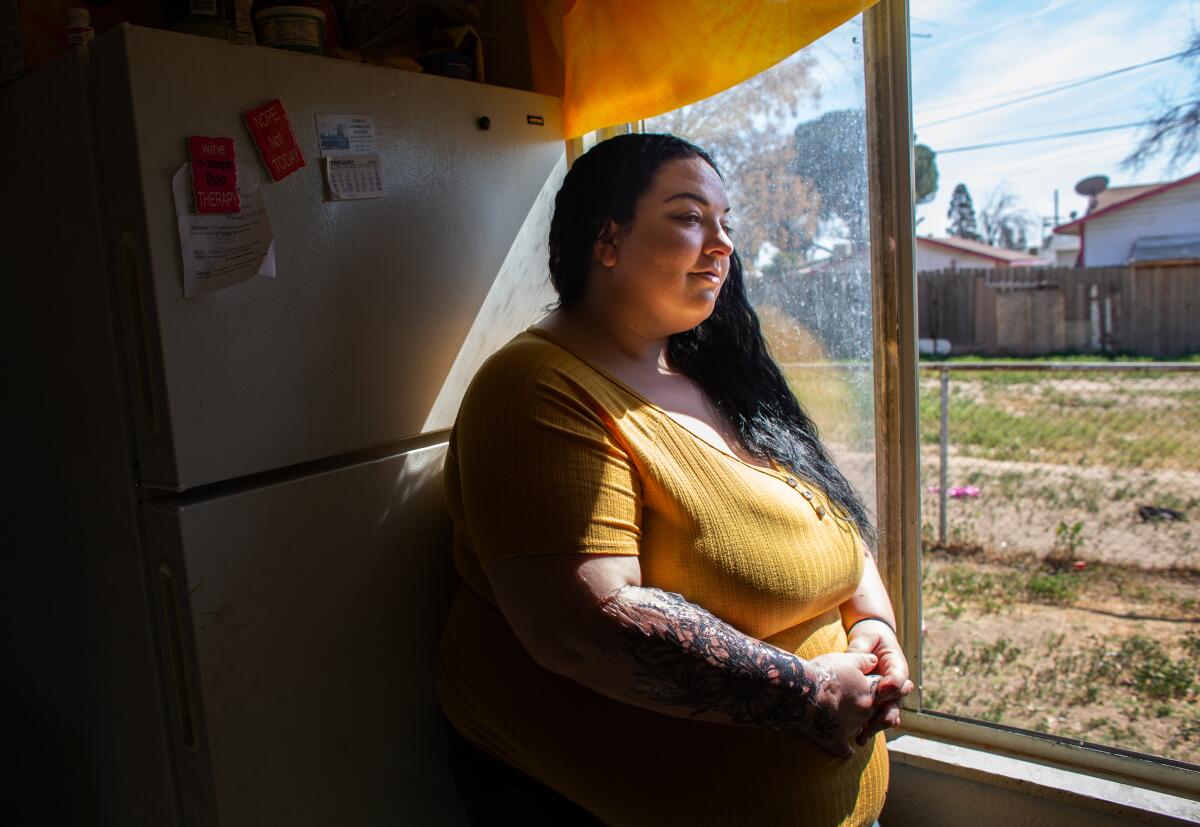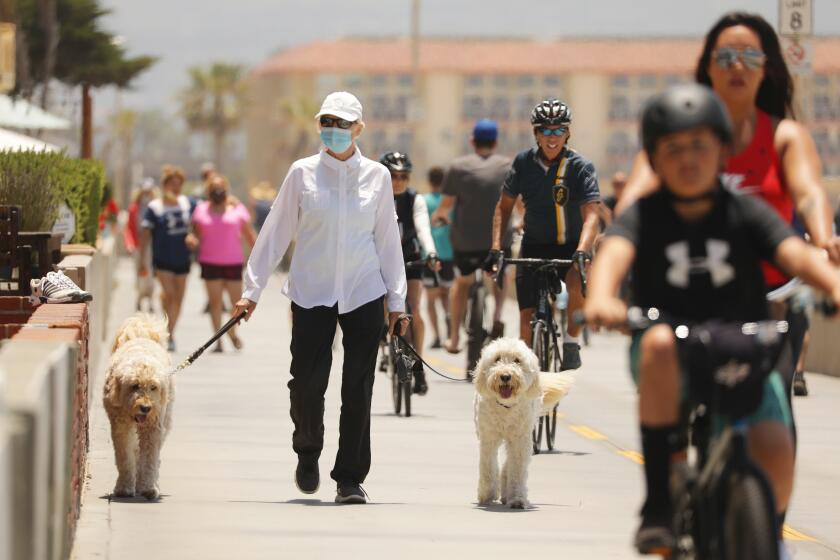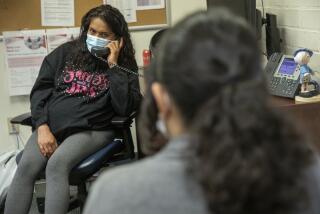Coronavirus widens healthcare divide between red states and blue states

BAKERSFIELD — Jenny Morones and Courtney Marrs are both working mothers. Both labor to raise three children on low incomes. Both fled abusive relationships.
But because Morones lives in California — a state that expanded its safety net through the Affordable Care Act — she has health coverage. It protected her from financial ruin last year when a severe infection put her in the hospital.
Marrs lives in Texas, which refused to expand Medicaid through the healthcare law. That’s left her and hundreds of thousands of other Texans uninsured. Lack of coverage has forced Marrs to forgo asthma inhalers and dental work on a molar she said was broken in a domestic dispute. “I’ve been living on Orajel,” she said.
Regional differences have long been a hallmark of American healthcare. But the gap between blue and red states has yawned wider in the 10 years of political battles that followed passage of the 2010 health law, often called Obamacare.
Now, the coronavirus crisis threatens to widen disparities further as tens of millions of Americans lose jobs and health coverage.
“Blue states and red states are moving in very different directions,” said Drew Altman, head of the nonprofit Kaiser Family Foundation, which studies the U.S. healthcare system.
Bernie Sanders, belying a reputation among many Democrats as a loose cannon, is stepping up to persuade his skeptical followers to support Joe Biden for president.
Few states illustrate the divergence more starkly than California and Texas, the nation’s two most populous states.
California — first under a GOP governor, then through two Democrats — has moved more aggressively than almost any other state to implement and build on the 2010 healthcare law.
The state expanded Medi-Cal coverage, as its Medicaid program is called, to nearly 4 million previously uninsured adults, built a robustly regulated insurance marketplace, enacted new patient protections and leveraged state power to push hospitals to improve quality and control costs.
The share of working adults without health coverage dropped from nearly a quarter to just 1 in 10 before the current public health crisis, according to federal data compiled by the nonprofit Commonwealth Fund.
“California is a remarkable story,” said Anthony Wright, the longtime head of Health Access California, one of the state’s leading consumer groups. “We were once a poster child for what was wrong with healthcare in America, but the state went from laggard to leader.”
Texas became the epicenter of Republican resistance to the Affordable Care Act. State leaders blocked Medicaid expansion, leaving more than 750,000 low-income Texans without access to coverage. Even before the coronavirus outbreak, a quarter of working-age Texans lacked health insurance.
The state also refused to establish its own insurance marketplace and dropped quality-improvement initiatives funded by the healthcare law.
Today, Texas heads an effort by 19 GOP-led states and the Trump administration to get the Supreme Court to invalidate the whole law. That case has continued despite the mounting toll from the pandemic; the justices will consider it in the fall.
California leads a coalition of states defending the law.
To be sure, California’s healthcare activism hasn’t made care affordable to everyone. And the deepening economic crisis now imperils the state’s gains.
For those who make too much to qualify for free Medi-Cal coverage or government subsidies, insurance premiums remain high in California.
That has angered many healthy consumers, who were able to get lower-cost health plans before insurers were required to cover people with preexisting medical conditions, a key protection in the Affordable Care Act that also pushed up premiums.
On the Memorial Day holiday, we recognize the valor of U.S. soldiers, sailors and airmen — regardless of whether the wars themselves were rightful.
But Covered California, the insurance marketplace the state created through the healthcare law, has moved aggressively to control costs. Since the marketplace debuted in 2014, premiums in California have risen much more slowly than the national average, data show.
“We knew that the Affordable Care Act was not self-implementing,” said Diana Dooley, who as health secretary under former Gov. Jerry Brown oversaw the state’s Medi-Cal expansion. “There were tools in the law if you chose to use them, but improvement wasn’t going to happen on its own.”
Outside Bakersfield, at the clinic where Morones comes for care, it’s not hard to see how the changes have helped patients.
The state-of-the-art North Chester Health Center — situated in a ragged neighborhood called Oildale, once home to Oklahoma migrants and other Dust Bowl refugees — is one of 20 clinics that Omni Family Health has opened since President Obama signed the Affordable Care Act.
Omni, a nonprofit health system, has been serving patients in the San Joaquin Valley for more than four decades. Historically, most were low-income. They were frequently very sick, having delayed care for chronic illnesses such as diabetes or heart disease. Many didn’t have health insurance.
With passage of the healthcare law, the percentage of uninsured patients at Omni plunged from 35% in 2010 to 9% in 2018.
The U.S. death toll from the coronavirus neared 100,000 on the holiday weekend as limits eased and Americans, including the president, went out to play.
Morones, who grew up in foster care and dreams of finishing a degree in child development, wasn’t able to get health insurance through the Greek restaurant where she works. But she qualified for Medi-Cal.
“It’s really good insurance. Everything is covered,” said Morones, 26, who didn’t hesitate to seek care when she was ill. “I’m so grateful.”
Between 2013 and 2017, the share of Californians who skipped medical care in the previous year because of costs dropped by a quarter, falling to 12%, Commonwealth Fund data show.
California’s coverage gains have also meant more stable finances for health systems serving the poor.
Omni used new revenue to build clinics like the one in Oildale and expand services, including behavioral health, orthodontics, cardiology and other medical specialties that many poor patients once went without. Since 2010, the health system has tripled the number of medical providers and more than doubled the number of patients it sees.
“It has been remarkable,” said Omni Chief Executive Francisco Castillon, who noted the system’s reserves have also helped Omni weather the current crisis.
The mood is less upbeat in Baytown, Texas, where Legacy Community Health, a nonprofit serving poor patients around Houston, operates a health center in the shadow of one of the nation’s largest oil refineries.
More than 1 in 3 patients there lack health coverage. Clinic staff scramble to put together care plans, get patients into drug discount programs, enroll them in charity or seek out the handful of specialists they know will see patients unable to pay.
“We try to manage diseases as best we can, but a lot of times we are racing against the clock,” said Dr. Eli Newsome, a family physician at the clinic. “I put in a referral, but it doesn’t go anywhere.”
Legacy is now planning for a surge as large as 30% or 40% in the number of uninsured adults it cares for because of the coronavirus outbreak and a major downturn of the oil industry, said Katy Caldwell, its director.
Charity programs such as the Rose, a Houston nonprofit that provides money for mammograms, can help, but they often have limited slots. So, too, do local hospitals, which cap charity care.
Everyone at Legacy has stories of patients slipping through the cracks.
“The ones who come in with cancer are the really difficult ones,” said Yvette Enriquez, an eligibility specialist who tries to connect patients with aid.
The share of working-age adults in Texas without coverage is down from 30% before the healthcare law’s coverage expansion began, but it still ranks highest in the country.
Even Texans who have insurance pay higher premiums and higher deductibles than Californians, data from the Kaiser Family Foundation show. And Texans are almost twice as likely as Californians to skip care because of cost.
They’re also more likely to struggle with medical debt. Nearly 30% of Texans reported past-due medical bills in 2018, compared with 14% of Californians.
The persistently high uninsured rate in Texas not only harms patients, but it also strains hospitals, doctors and other medical providers. And it has slowed initiatives to organize medical care so patients get better results and avoid costly and unnecessary tests and procedures.
“We’re about 15 years behind California in terms of taking on costs in a meaningful way,” said Tom Banning, head of the Texas Academy of Family Physicians.
Texas Gov. Greg Abbott’s office did not respond to repeated requests for comment.
California, on the other hand, is taking steps to expand the federal healthcare law’s protections.
Covered California, for example, has worked aggressively to control what patients have to pay, advertising to attract younger, healthier consumers who cost less to insure and mandating that health plans exempt some services from deductibles so patients won’t skip needed care. Roughly 1.5 million people get coverage through Covered California, and more than 70% are now in a plan in which primary care visits, lab tests or other outpatient services aren’t subject to a deductible.
Texas offers no such aid to the 1.1 million people who get marketplace coverage there. Nor does the state have any plans to expand consumer protections.
There remain no options for patients such as Marrs, who earned too little to qualify for marketplace coverage but is shut out of Medicaid in Texas.
Marrs doesn’t regret that her divorce meant giving up the health insurance she had through her husband’s job.
But living with a broken wisdom tooth for more than two years and having to reuse contact lenses so frequently she injured her eyes hasn’t been easy.
As she sat in the waiting room of a clinic that serves low-income patients, she shook her head at the choice she confronted.
“I had to decide if I was going to stay in a really bad situation to keep my insurance or leave for the sake of my safety and the safety of my kids, knowing I’d lose my insurance,” she said.
“It’s crazy.”
More to Read
Get the L.A. Times Politics newsletter
Deeply reported insights into legislation, politics and policy from Sacramento, Washington and beyond. In your inbox three times per week.
You may occasionally receive promotional content from the Los Angeles Times.















